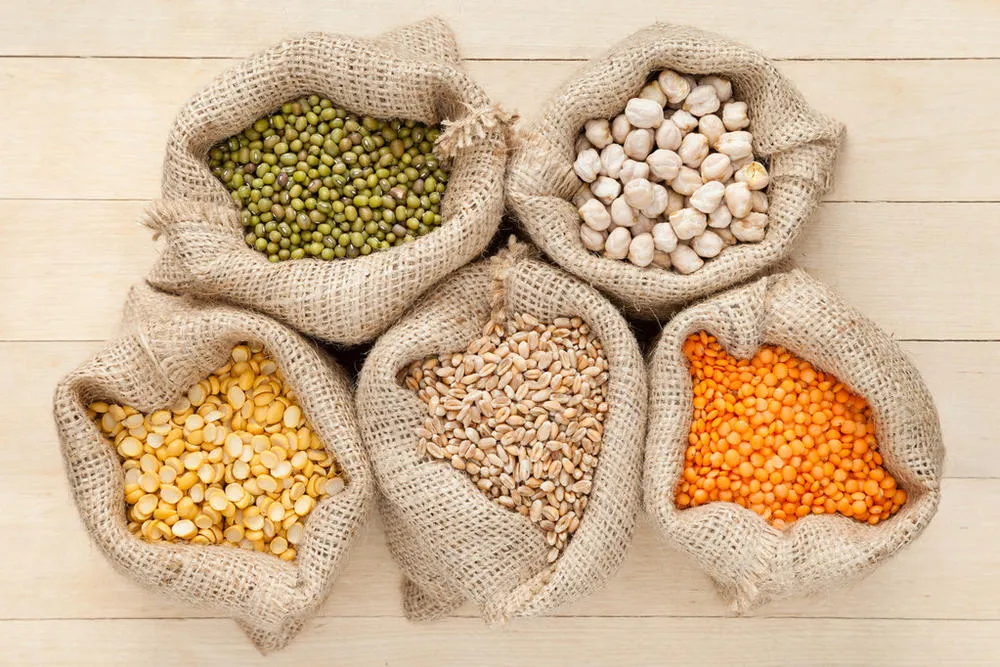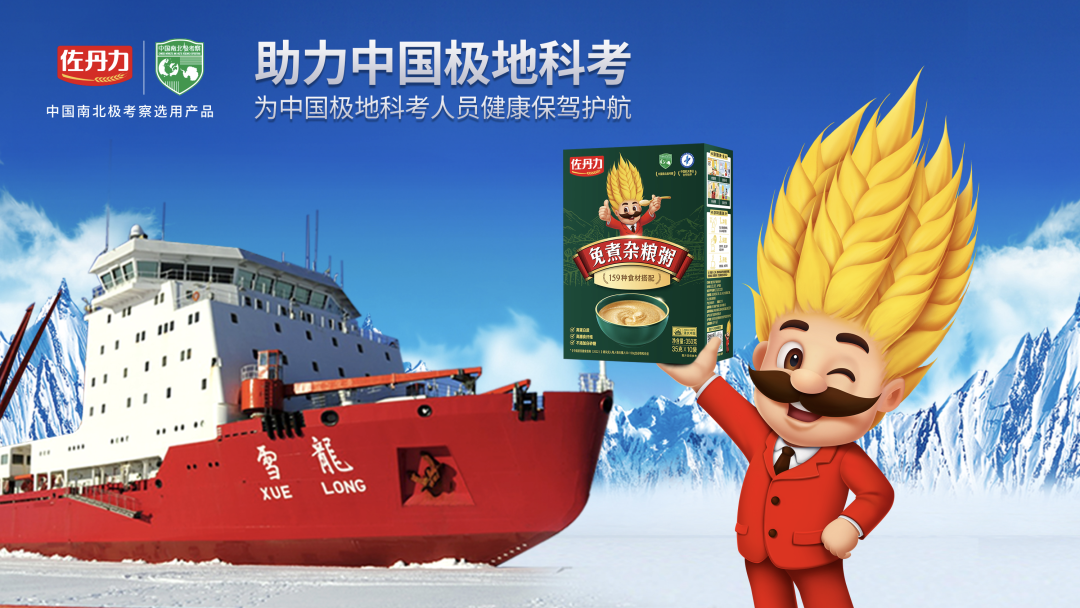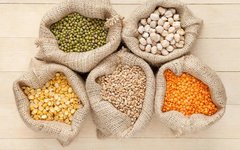
There are many different versions of the “Five Grains” (五谷), with the two most important being: one refers to rice (稻), millet (黍), broomcorn millet (稷), wheat (麦), and beans (菽); the other refers to hemp (大麻), foxtail millet (小米), common millet (小米), wheat (小麦), and corn (蜀黍). In modern terms, the Five Grains often refer to: rice (稻谷), wheat (麦子), legumes (豆类), corn (玉米), and tubers (薯类). Additionally, grains other than rice and flour are commonly referred to as whole grains, and the term “Five Grains” also broadly refers to cereal crops, thus encompassing all grain crops.
Six Benefits of Whole Grains
1. Disease prevention and health maintenance
2. Cancer resistance
3. Detoxification
4. Memory enhancement
5. Beauty and skin health
6. Promoting fat metabolism
Whole grains nourish the five organs. In ancient times, there was a saying that “one grain nourishes one organ”.
Soybeans are particularly beneficial for the kidneys, rice for the lungs, millet for the spleen, sorghum for the liver, and wheat for the heart.
Nutritional Value of 21 Types of Whole Grains
1
Millet (小米): Calming and digestive aid
Millet benefits the kidneys and stomach, clears heat, nourishes deficiency, calms the mind, and aids digestion.
Rich in tryptophan, millet is easily absorbed and promotes the secretion of serotonin, making it an excellent food for sleep and digestion.
2
Sorghum (高粱): Strengthens the spleen and benefits the stomach
Sorghum warms the middle, astringes the intestines, stops diarrhea, promotes urination, strengthens the spleen, and clears the stomach. It has significant therapeutic effects for children with indigestion and adults with spleen and stomach qi deficiency.
For children with indigestion, sorghum can be roasted, shelled, and ground into powder, with 2-3 grams taken each time. However, due to its warming nature and tannins that can astringe and stop diarrhea, it is not suitable for those with constipation.
3
Job’s Tears (薏米): Heat-clearing and body-strengthening
Job’s Tears contain more protein than rice and wheat, are easily digestible, and help reduce gastrointestinal burden and enhance physical strength. They clear heat, strengthen the spleen, nourish the lungs, stop diarrhea, and reduce edema.
They can alleviate mild inflammation of the intestines and stomach, making them suitable for those with beriberi and edema, and can also improve acne, lighten dark spots, freckles, and rough skin.
4
Fox Nut (芡实): Anti-aging
Fox Nut nourishes the spleen and kidneys, astringes and stops diarrhea, relieves pain, calms the mind, and alleviates symptoms such as diarrhea, neuralgia, and rheumatic joint pain.
It also strengthens the spleen and stomach, nourishes blood, enhances hearing and vision, beautifies the skin, and has anti-aging properties.
5
Buckwheat (荞麦): Lowers blood lipids
Buckwheat benefits qi, opens the appetite, clears heat, and detoxifies. Clinically, it is used to prevent and treat hypertension, stroke, arteriosclerosis, and nephritis.
Its high content of linoleic acid can lower cholesterol and blood lipids.
6
Yellow Soybeans (黄豆): Strengthens the middle and benefits qi
Known as the “king of beans,” yellow soybeans are considered “plant meat” due to their rich nutritional value.
They strengthen the spleen, moisten dryness, promote urination, benefit qi, and clear heat. Those with spleen and stomach deficiency should consume them regularly. Yellow soybeans can prevent and improve breast cancer, prostate cancer, menopausal symptoms, and osteoporosis; they help maintain vascular elasticity, improve iron deficiency anemia, and alleviate neurasthenia.
Various soybean products made from yellow soybeans, such as tofu and soy milk, also have medicinal properties: tofu can benefit qi, clear heat, and disperse blood, especially suitable for those with phlegm-heat cough, wind-cold, and sore throat.
7
Oats (燕麦): Lowers blood sugar
Oats nourish the spleen and kidneys, stop bleeding, reduce swelling, and strengthen the body. The linoleic acid in oats is beneficial for diabetes and constipation, helps lower cholesterol, and stabilizes blood sugar levels.
8
Brown Rice (糙米): Aids digestion
Brown rice aids digestion and is easier to digest and absorb than white rice, preventing beriberi and detoxifying. Brown rice retains the germ, which constitutes only 3% of the grain but contains 70% of the vitamins and minerals, especially vitamin B1.
It is rich in dietary fiber, promoting the proliferation of beneficial gut bacteria, accelerating intestinal peristalsis, softening stools, and preventing constipation and colon cancer; dietary fiber can also bind with cholesterol in bile, promoting its excretion, thus helping patients with hyperlipidemia lower their blood lipids.
9
Black Beans (黑豆): Nourishes and strengthens yang
Black beans are a cooling and nourishing yang herb. Consuming them in moderation can effectively treat diabetes, vision decline, premature graying, eczema, beriberi, and anemia. Eating black bean powder mixed with sesame and walnut powder can enhance hair color and shine.
Due to modern work stress, many people experience fatigue. To enhance vitality and energy, according to traditional Chinese medicine, kidney tonification is essential. Black beans are an effective kidney tonic.
According to TCM theory, beans are the grains of the kidneys, and black is associated with water, which governs the kidneys, making black beans beneficial for those with kidney deficiency. They also have beauty-enhancing effects for young women.
10
Purple Rice and Black Rice (紫米、黑米): Eye protection
Black rice is a precious variety of glutinous rice, ideal for patients with diabetes and cardiovascular diseases, and is a highly nutritious tonic, referred to as “Imperial Red Rice” in “Dream of the Red Chamber”.
Purple and black grains are generally rich in anthocyanins, which have antioxidant properties, preventing fat oxidation and maintaining eye vascular health.
11
Sesame (芝麻): Activates blood and beautifies
Sesame moistens the intestines and promotes bowel movements, activates blood circulation, enhances beauty, promotes black hair, and has brain-boosting, memory-enhancing, and anti-aging effects.
Sesame contains substances that prevent weight gain, and when combined with a diet for weight loss, it can improve rough skin.
12
Wheat (小麦): Strengthens the spleen and nourishes the heart
Wheat is sweet, neutral, and slightly cold, with effects of strengthening the spleen, benefiting the kidneys, and nourishing the heart and calming the mind. Those with irritability and insomnia can cook wheat with rice and jujubes to make porridge.
Additionally, wheat bran is high in dietary fiber, which can prevent and treat hyperlipidemia, diabetes, arteriosclerosis, hemorrhoids, senile constipation, and colon cancer.
13
Corn (玉米): Lowers cholesterol
Corn is sweet and neutral, with effects of strengthening the spleen, promoting diuresis, enhancing appetite, and calming the heart while activating blood circulation. The linoleic acid in corn oil can prevent cholesterol from depositing on blood vessel walls, positively impacting hypertension and coronary heart disease.
Additionally, it has diuretic and blood sugar-lowering effects, making it particularly suitable for diabetic patients. American scientists have also found that eating corn can stimulate brain cells and enhance memory.
The lutein and zeaxanthin in corn can prevent age-related macular degeneration.
14
Green Beans (绿豆): Heat-clearing and detoxifying
Green beans are cold in nature and have heat-clearing and detoxifying functions. They are rich in nutrients and are excellent for preventing heatstroke, and can be made into various pastries, noodles, and fermented green bean products.
15
Red Beans (红豆): Clears heart fire and nourishes heart blood
Traditional Chinese medicine believes that red beans clear heat, dispel dampness, reduce swelling, detoxify, calm the heart, and nourish blood, while also providing potassium, magnesium, phosphorus, zinc, selenium, and other nutrients.
Li Shizhen referred to red beans as the “grain of the heart”; they can clear heart fire and nourish heart blood.
Additionally, red beans are rich in dietary fiber, which helps lower blood lipids, blood pressure, and improve cardiac function.
Red beans are rich in starch, hence they are also called “rice beans”; they have functions of promoting body fluids, facilitating urination, reducing bloating, alleviating swelling, and stopping vomiting. Red beans are an essential high-nutrition, multifunctional whole grain in daily life.
16
Peanuts (花生): Longevity fruit
Peanuts are one of the “top ten longevity foods,” rich in vitamins, protein, fats, riboflavin, unsaturated fatty acids, calcium, phosphorus, etc., and are effective for treating digestive disorders, cough, asthma, anemia, constipation, and intestinal dryness, making them suitable for all ages.
17
Sweet Potatoes (红薯): Prevents cardiovascular diseases
Sweet potatoes are low in calories and fat, and can prevent carbohydrates from turning into fat, making them effective for weight loss in autumn and winter.
Moreover, sweet potatoes are rich in potassium, beta-carotene, folic acid, vitamin C, and vitamin B6, all of which help prevent cardiovascular diseases.
18
Fava Beans (蚕豆): Enhances memory
Fava beans contain important components that regulate the brain and nervous tissue, such as calcium, zinc, manganese, and phospholipids, and are rich in choline, which enhances memory.
The calcium in fava beans aids in calcium absorption and calcification in bones, promoting skeletal growth and development.
19
Kidney Beans (芸豆): Beneficial for the heart
Kidney beans contain saponins, urea enzymes, and various globulins, which effectively boost immunity and activate lymphocyte T cells, while urea enzymes are particularly effective for patients with hepatic coma.
Kidney beans are also a high-potassium, low-sodium food, making them suitable for patients with heart disease, arteriosclerosis, hyperlipidemia, and those on a low-salt diet.
20
Lentils (扁豆): Lowers cholesterol
Small lentils provide protein and soluble fiber that can lower cholesterol, and their iron content is double that of other beans.
Small lentils are also high in vitamin B and folic acid, which are very important for women, as they can reduce the risk of fetal malformations.
21
Yardlong Beans (豇豆): Regulates qi and benefits the middle
Yardlong beans have effects of regulating qi, strengthening the stomach, nourishing the kidneys, harmonizing the five organs, promoting vitality, stopping thirst, alleviating vomiting and diarrhea, and detoxifying. They are indicated for vomiting, dysentery, and frequent urination.
Healthy Eating Methods
1
Job’s Tears Soup is the most nourishing
A bowl of soup before meals promotes health! Job’s Tears soup is a favorite among women for health and beauty. Ingredients like lotus seeds and Job’s Tears nourish the spleen and stomach and replenish vital energy, making it popular among couples preparing for pregnancy.
Main ingredients: peanuts, Job’s Tears.
Method:
1. Blanch the peanuts in boiling water, then place them in a soup pot.
2. Add ginger slices, lotus seeds, lily, a small amount of Job’s Tears, and two pieces of dried tangerine peel, then pour in an appropriate amount of boiling water.
3. After the soup is cooked, add a small amount of salt before serving.
2
Growing bodies should eat buckwheat noodles
Buckwheat noodles are made from gray-black flour, but despite their unassuming appearance, they are highly nutritious. Buckwheat can be prepared in various ways, but the most common is as noodles.
They are particularly suitable for the elderly and children; occasional consumption can help lower blood lipids and blood pressure in the elderly.
Children should not eat buckwheat noodles for breakfast or dinner, as they can be hard to digest; moderation is key.
3
Glutinous Rice is suitable for porridge
Glutinous rice can be used to make porridge or tangyuan (sweet rice balls). It aids digestion and has calming effects, alleviating fatigue and dizziness.
4
Oat Eight-Treasure Rice is great for weight loss
Oats are often soaked in drinks, but making Eight-Treasure Rice with oats can enhance beauty and delay aging. Oats contain various enzymes that inhibit the formation of age spots and delay cellular aging, making them an excellent health food for middle-aged and elderly patients with cardiovascular diseases.
5
Whole Grain Soy Milk
Drinking a cup of whole grain soy milk daily can increase health benefits by more than three times compared to not drinking it. Therefore, it is advisable to purchase several types of whole grains, which can be directly blended in a soy milk machine. While brushing your teeth in the morning, you can prepare the whole grains, and by the time you finish brushing and washing your face, you will have a fragrant, high-protein soy milk ready to drink, providing the best energy source for your day.
More and more people are beginning to recognize the benefits of whole grains. In addition to their nutritional value, whole grains can also help alleviate or treat diseases. Consumers of all ages should consume them appropriately for health benefits.Some patients can also use whole grains for health maintenance, cooking them for consumption or combining them with medicines, but it is essential to pay attention to food compatibility.

▲ Click the image above to enter the mini-program mall

Some images and texts are sourced from the internet, with respect to the original authors. If there are any questions, please contact us for proper handling. We welcome submissions; please send to: [email protected]
▼Click “Read the original text” to enter the mall

